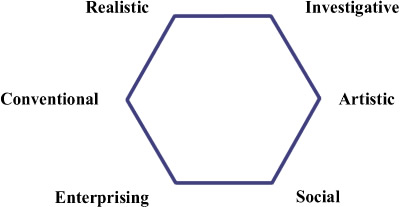 |
Holland's Theory of Career Choice and You
Choosing an Occupation, Training Program, Major, Career Cluster or Pathway
The Career Key is based on John Holland's theory of career choice. The theory explains work-related behavior – such as, which career choices are likely to lead to job success and satisfaction. It also explains other human actions, like success and satisfaction in school and training programs. It is the best known and most widely researched theory on this topic and is used by most career counselors.
Understanding Holland’s theory will help you make good choices – decisions about which occupations, careers, majors, or training programs best fit you.
When you take the Career Key test, you receive an accurate assessment of your Holland personality types and a booklet What Your Test Scores Means that explains Holland's theory and how your test scores are related to it and career choice.
Holland's theory can be summarized in six statements:
- In our culture, most people are one of six personality
types: Realistic, Investigative, Artistic, Social, Enterprising,
and Conventional. Some refer to these as Holland Codes or RIASEC.
- People of the same personality type working together in a job create a work environment that fits their type. For example, when Artistic persons are together on a job, they create a work environment that rewards creative thinking and behavior -- an Artistic environment.
- There are six basic types of work environments: Realistic, Investigative, Artistic, Social, Enterprising, Conventional.
- People search for environments where they can use their skills and abilities and express their values and attitudes. For example, Investigative types search for Investigative environments; Artistic types look for Artistic environments, and so forth.
- People who choose to work in an environment similar to their personality type are more likely to be successful and satisfied.
For example, Artistic persons are more likely to be successful and satisfied if they choose a job that has an Artistic environment, like choosing to be a dance teacher in a dancing school -- an environment "dominated" by Artistic type people where creative abilities and expression are highly valued.

- How you act and feel at work depends to a large extent on your workplace (or school) environment. If you are working with people who have a personality type like yours, you will be able to do many of the things they can do, and you will feel most comfortable with them. How is this related to the scores you receive on the Career Key?
How is this related to the scores you receive on the Career Key? According to the theory, you want to choose an occupation whose personality type is the same as, or similar to yours. This is most likely to lead to your job satisfaction and success. (Learn more about how this applies to college majors, training programs or to Career Clusters, Fields, and Pathways).
A good match-up is called "Congruent" (meaning "compatible, in agreement or harmony"). For example, imagine that your highest score on the Career Key is for the Realistic type. Looking at the table below, you can see that the most compatible job environment is Realistic. It is a congruent match. This suggests that you choose a job in the Realistic group. Or, you might choose from the jobs that fall in the Investigative or Conventional category.
| Compatible
Work Environments |
| Your
Personality Type |
Most
Compatible |
Compatible |
| Realistic |
Realistic |
Investigative & Conventional |
| Investigative |
Investigative |
Realistic & Artistic |
| Artistic |
Artistic |
Investigative & Social |
| Social |
Social |
Artistic & Enterprising |
| Enterprising |
Enterprising |
Social & Conventional |
| Conventional |
Conventional |
Enterprising & Realistic |
Most people, in reality, are a combination of types
-- like Realistic-Investigative, or Artistic-Social. Therefore,
you will probably want to consider occupations in more
than one category.
If your two strongest personality types are Realistic
and Social, Investigative and Enterprising, or
Artistic and Conventional -- read
the following.
In summary, you are most likely to choose a satisfying
job if you choose one that fits your personality
type.
Holland's Hexagon
John Holland created a hexagonal model that shows the relationship between the personality types and environments.

Notice that the personality types closest to each other are more alike than those farther away. You can see this most clearly when you compare the personalities opposite each other, on the hexagon. For example, read the description of the types for Realistic and Social. You will see that they are virtually the opposite of each other. On the other hand, Social and Artistic are not that far apart.
The same holds true for the work environments. Read their descriptions and you will see.
You will learn more about this fascinating and respected theory when you read What Your Test Scores Mean.
|
 |